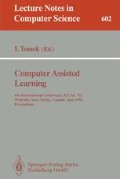Abstract
The post-TV media of computers and communications enables teachers, students, and parents to creatively develop education by engagement and construction (Figure 3). Students should be given the chance to engage with each other in team projects, possibly situated in the world outside the classroom, with the goal of constructing a product that is useful or interesting to someone other than the teacher. Challenges remain such as scaling up from small class projects to lecture sections with hundreds of students, covering the curriculum that is currently required by many school districts, evaluating peformance, and assigning grades. However, there seems to be no turning back and, anyway, the children of the Nintendo and Video Age are eager to press fast forward.
Also Head of the Human-Computer Interaction Laboratory and a Member of the Systems Research Center. Parts of this paper were derived from [Shn92a].
Preview
Unable to display preview. Download preview PDF.
References
American Association for Higher Education. Principles for Good Practice in Undergraduate Education, 1987.
Marshall McLuhan. Understanding Media: The Extensions of Man, McGraw-Hill Book Company, New York, NY, 1964.
National Institute of Education. Involvement in Learning: Realizing the Potential of American Higher Education, Final Report of the Study Group on the Conditions of Excellence in American Higher Education, 1984.
Jean Piaget. Cognitive development in children: the Piaget papers, In R. E. Ripple and V. N. Rockcastle (Editors), Piaget rediscovered: a report of the conference on cognitive studies and curriculum development, Ithaca School of Education, Cornell University, pp. 6–48, 1964.
Ben Shneiderman. Education by Engagement and Construction: A Strategic Education Initiative for a Multimedia Renewal of American Education, In, Barrett, ED (Editor), The Social Creation of Knowledge: Multimedia and Information Technologies in the University, MIT Press, Cambridge, MA, 1992.
Ben Shneiderman. Designing the User Interface: Strategies for Effective Human-Computer Interaction, Second Edition, Addison-Wesley Publ. Co., Reading, MA, 1992.
W. R. Wees. Nobody Can Teach Anybody Anything, Doubleday Canada, Toronto, Ontario, 1971.
Author information
Authors and Affiliations
Editor information
Rights and permissions
Copyright information
© 1992 Springer-Verlag Berlin Heidelberg
About this paper
Cite this paper
Shneiderman, B. (1992). Engagement and construction: Educational strategies for the post-TV era. In: Tomek, I. (eds) Computer Assisted Learning. ICCAL 1992. Lecture Notes in Computer Science, vol 602. Springer, Berlin, Heidelberg. https://doi.org/10.1007/3-540-55578-1_56
Download citation
DOI: https://doi.org/10.1007/3-540-55578-1_56
Published:
Publisher Name: Springer, Berlin, Heidelberg
Print ISBN: 978-3-540-55578-0
Online ISBN: 978-3-540-47221-6
eBook Packages: Springer Book Archive

